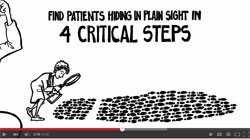Undiagnosed Hypertension
 Hypertension is a leading cause of heart disease and stroke. Millions of people with hypertension are seen by providers each year, but many remain undiagnosed—essentially “hiding in plain sight” within clinical settings.
Hypertension is a leading cause of heart disease and stroke. Millions of people with hypertension are seen by providers each year, but many remain undiagnosed—essentially “hiding in plain sight” within clinical settings.
High blood pressure, or hypertension, affects millions of Americans, and some have hypertension that is undiagnosed and untreated—they are “hiding in plain sight.” Because hypertension rarely has symptoms, it’s not often a topic patients discuss with their health care providers. Even while following best practices and providing the highest level of care, providers can have patients who are at risk for hypertension or who remain undiagnosed.
Million Hearts®, a national effort to prevent 1 million heart attacks and strokes by 2017, has made blood pressure control a priority. Million Hearts® encourages health care providers to take steps to identify patients with potentially undiagnosed hypertension.
The Facts about Hypertension
- Uncontrolled hypertension is a leading cause of heart disease and stroke.1 It also raises the risk for kidney and heart failure.
- One in three U.S. adults—about 70 million people—has hypertension.2 Almost half of these people don’t have their blood pressure under control.3
- About 13 million U.S. adults with hypertension aren’t even aware they have it and are not being treated.2
- Most people with uncontrolled blood pressure have health insurance and see their providers at least twice a year,3 but remain undiagnosed.
What Providers Can Do

Video: Finding Undiagnosed Hypertensive Patients
Watch this video to learn how to find patients in your practice who may be “hiding in plain sight” with undiagnosed hypertension.
Make hypertension control a priority for your practice. Follow these four critical steps to help you identify patients with potentially undiagnosed hypertension who are hiding in plain sight:
- Establish clinical criteria for potential undiagnosed hypertension using current evidence-based guidance. Work with your health care team to determine the number of elevated blood pressure readings and the degree of elevation that should trigger a red flag for a patient.
- Search electronic health record (EHR) data for patients who meet your established clinical criteria. For example, some providers have searched EHR registries using algorithms to extract relevant information.4 Pick the approach that works best for your practice based on your available resources.
-
Implement a plan to communicate with these patients and to treat those with hypertension.
The plan could include 24-hour ambulatory or home blood pressure monitoring, automated office blood pressure readings, or repeated in-office measurement. For patients with confirmed hypertension, follow standardized treatment protocols and provide feedback to your care team about how best to support patients in achieving and maintaining blood pressure control. - Calculate the hypertension prevalence in your practice and compare your data against local, state, or national prevalence data. Comparing the prevalence of hypertension among your patients to national or local values could add much-needed context to blood pressure control rates and may help identify more patients who might benefit from additional clinical action.
Start with the steps that make the most sense for your practice. What’s important is that you begin the process. Bringing those patients who are hiding in plain sight into clear view and spreading the word about how other health care professionals can find them will help protect millions from unnecessary and preventable events.
Hypertension Prevalence Estimator Tool
The interactive Million Hearts® Hypertension Prevalence Estimator Tool generates an expected percentage of patients with hypertension based on the specific characteristics of your health system’s or practice’s patient population. Compare the expected prevalence to the calculated prevalence—if the values are significantly different, you may have patients “hiding in plain sight” with undiagnosed hypertension. Use the tool.
Resources to Help Find Patients with Undiagnosed Hypertension
The following resources can help you diagnose, treat, and manage hypertension in your practice.
- Undiagnosed Hypertension Change Package — This guide can help clinicians map and identify enhancements to clinical workflows that improve detection and diagnosis of hypertension.
- Hypertension Control: Change Package for Clinicians [679 KB]—This guide is a quality improvement tool for ambulatory clinical settings to improve hypertension control. It provides health care providers with an evidence base of process improvements to more efficiently and effectively care for hypertensive patients.
- Hypertension Control: Action Steps for Clinicians [312 KB]—This guide offers proven strategies to help clinicians work with their patients to control hypertension, including creative ways to deliver care, improve medication adherence, and optimize patient reminders and supports.
- High Blood Pressure —This site provides fact sheets, data and statistics, and other helpful resources for patients and practitioners.
References
- Nwankwo T, Yoon SS, Burt V, Gu Q. Hypertension among adults in the US: National Health and Nutrition Examination Survey, 2011-2012 [777 KB] NCHS Data Brief, No. 133. Hyattsville, MD: National Center for Health Statistics, Centers for Disease Control and Prevention, US Dept of Health and Human Services, 2013.
- D Mozaffarian et al (2016). Heart Disease and Stroke Statistics — 2016 Update. Circulation; 133: e38-e360. doi: 10.1161/CIR.0000000000000350.
- Yoon S, Fryar C, Carroll M. Hypertension Prevalence and Control Among Adults: United States, 2011–2014. NCHS Data Brief, No. 220. Hyattsville, MD: National Center for Health Statistics, Centers for Disease Control and Prevention, US Dept of Health and Human Services, 2015.
- D Banerjee et al (2012). Underdiagnosis of hypertension using electronic health records . Am J Hypertens ; 25(1):97-102.
More Information
- Page last reviewed: April 6, 2016
- Page last updated: April 6, 2016
- Content source:
- National Center for Chronic Disease Prevention and Health Promotion, Division for Heart Disease and Stroke Prevention
- Page maintained by: Office of the Associate Director for Communication, Digital Media Branch, Division of Public Affairs




 ShareCompartir
ShareCompartir